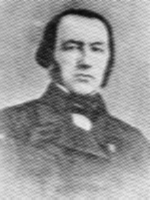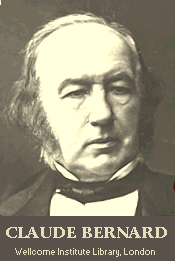
Experimenting on animals is a controversial practice. Many people think that animals have rights and should not be subjected to experimentation. Medical researchers, however, hold the view that animal research is necessary to human welfare and is certainly more defensible than eating animals. Experimenting on animals, also known as vivisection, was established as acceptable scientific practice by Claude Bernard. It was he who showed how much could be learned and applied to medical practice through vivisection.
In defending biomedical research on animals, the American Medical Association says:
“In fact, virtually every advance in medical science in the 20th century, from antibiotics and vaccines to antidepressant drugs and organ transplants, has been achieved either directly or indirectly through the use of animals in laboratory experiments.”
 Claude Bernard was born near Villefranche (20km north of Lyons-see photo on right of his birthplace, now a museum), where his father worked the Chevalier de Quincieux estate. His father was a winemaker and Claude helped him tend the vineyards and process the harvest. His mother, Jeanne Saulnier, had a peasant background. His father went broke in a wine-marketing venture, and the family was poor. Claude studied Latin with a local priest and was taken in as a student in a Jesuit school at Villefranche. That school taught no science, and it is amazing that Claude developed an early interest in science. He studied at the middle school in Thoissey, but he quit school, without a diploma, and apprenticed to a chemist named Millet in a Lyon suburb. His work there was apparently boring, but he did enjoy the errands he ran to the nearby veterinary school.
Claude Bernard was born near Villefranche (20km north of Lyons-see photo on right of his birthplace, now a museum), where his father worked the Chevalier de Quincieux estate. His father was a winemaker and Claude helped him tend the vineyards and process the harvest. His mother, Jeanne Saulnier, had a peasant background. His father went broke in a wine-marketing venture, and the family was poor. Claude studied Latin with a local priest and was taken in as a student in a Jesuit school at Villefranche. That school taught no science, and it is amazing that Claude developed an early interest in science. He studied at the middle school in Thoissey, but he quit school, without a diploma, and apprenticed to a chemist named Millet in a Lyon suburb. His work there was apparently boring, but he did enjoy the errands he ran to the nearby veterinary school.
Claude Bernard worked with François Magendie the leading physiologist of his time. For a while, Claude worked in Magendie’s shadow, but it soon became clear that Claude could hold his own with the best, even Magendie. In 1854 a chair of general physiology was created for Claude in the Sorbonne, and he was elected to the Academy of Sciences. When Magendie died in 1855, Bernard succeeded him as full professor before succeeding him to the experimental medicine chair at the Ollège de France in 1855.
 Claude did not have his own laboratory at first, but his fame was such that he had a personal interview with Emperor Napoleon who made sure that a lab was constructed for him.
Claude did not have his own laboratory at first, but his fame was such that he had a personal interview with Emperor Napoleon who made sure that a lab was constructed for him.
During most of the 1800s, France was the world leader in medicine, and Claude Bernard grew up in that culture where advances in medicine were being driven by the scientific method. Claude became a leader in using the scientific method and, in fact, is generally considered the founder of modern experimental physiology. One of the lasting contributions he made was his demonstration of the value of hypothesis-driven research. Claude’s experiments began with a hypothesis, and tests were designed that would either support or refute the hypothesis, and that in turn guided the next steps in experimentation. Claude had three guiding principles for his own research; he believed that 1) the notion of “vital force” does not explain life; (2) animal research (vivisection) is indispensable for physiological research; and (3) life is mechanistically determined by physic-chemical forces.
Of the many lasting discoveries made by Claude, one stands out because it is such a fundamental principle. The principle (called a scientific law in Physics) is that the internal workings of warm-blooded animals are more or less constant, and that physiological mechanisms resist external forces that would alter this state. This is the principle of homeostasis, which was further advanced by his successor Walter Cannon.
Among his many other discoveries were experimental demonstrations of many of the functions of the liver. He showed that secretions of the pancreas contained digestive enzymes. He showed that certain parts of the pancreas were involved in diabetes. He also showed that the contraction and relaxation of small blood vessels were regulated by nerves. In addition, he demonstrated that there was a functional junction between nerves and muscle and that curare blocks this junction. If they had been awarding Nobel Prizes in those days, Claude would have won several. His contemporary, Louis Pasteur, called him “physiology itself.”
Ironically, the organ systems that Claude spent so many years studying were the very ones that caused his own illness and death. Claude apparently developed chronic enteritis, with disease affecting the pancreas and the liver.
Biography of Claude Bernard, 1813-1878
| 1810-1820 | 1820-1830 | 1830-1840 | 1840-1850 | 1850-1860 | 1860-1870 | 1870-1880 |
|---|---|---|---|---|---|---|
| 1813 Born on 12th July at St Julien, Rhône, France | 1827 Pupil at the college in Villefranche | 1831 Leaves the college in Thoissey 1832 Apprentice in Millet’s Pharmacy in Vaise, then a suburb of Lyon 1833 Leaves St Julien for Paris 1834 Obtains his baccalaureate 1837 Appointed extern of the Paris hospitals 1939 Appointed intern of the Paris hospitals | 1843 Doctor of Medicine. Thesis on gastric juices. Discovers the glycogenic function of the liver. 1844 Fails the aggregation exam 1845 Marries Françoise Marie (Fanny) Martin 1846 Birth of a son Louis-Henri (dies at three months) 1847 Birth of a daughter, Jeanne-Henriette (Tony), died in 1923. Appointed substitute professor for Magendie at the Collège de France. Death of his father, Pierre Bernard. 1849 Naissance de Marie (meurt en 1922). Chevalier de la Légion d’honneur. | 1853 Doctor of Natural Science 1854 Elected member of the French Academy of Sciences. Occupies the chair of General Physiology in the Paris Faculty of Science (Sorbonne) 1855 Appointed professor of medicine at the Collège de France 1856 Birth of Claude-Henri (died in 1857) | 1861 Elected Member of the French Academy of Medicine 1865-1867 Convalescence after an illness (a sort of enteritis). Publication of his Introduction to the study of experimental medicine 1867 Death of his mother, Jeanne Saunier Appointed Commander of the French Legion of Honour 1868 Elected to the French Academy to the chair left vacant by the death of Flourens. His chair of General Physiology transferred to the French Museum of Natural History 1869 Officially separated from his wife. First letter to Madame Raffalovitch. Appointed Senator of the French Empire | 1876 Chief administrator of the Paris Universal Exhibition 1877 Last lecture at the Collège de France 1878 Dies on 10th February at 40 rue des Ecoles, Paris. National funeral takes place on 16th February at the church of Saint-Sulpice, Paris. He is buried in the Père-Lachaise cemetery, Paris, France |
References:
Bayliss, L.E. Living Control Systems, English University Press, London, 1966
LaFollette, Hugh and Niall Shanks. “Animal Experimentation: The Legacy of Claude Bernard”.
http://www.etsu.edu/philos/faculty/hugh/bernard.htm
The Claude Bernard Museum. http://www.claude-bernard.co.uk/page20.htm
